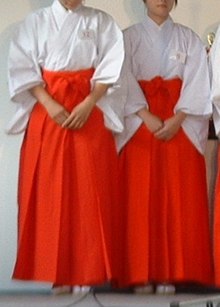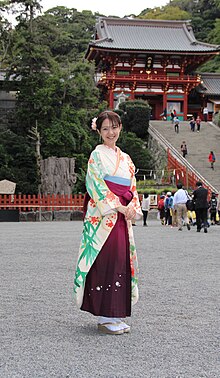This article needs additional citations for verification. (September 2011) |



Hakama (袴) are a type of traditional Japanese clothing. Originally stemming from kù (traditional Chinese: 褲; simplified Chinese: 裤), the trousers worn by members of the Chinese imperial court in the Sui and Tang dynasties, this style was adopted by the Japanese in the form of hakama in the 6th century. Hakama are tied at the waist and fall approximately to the ankles. They are worn over a kimono specially adapted for wearing hakama, known as a hakamashita.[1]
There are two types of hakama: divided umanori (馬乗り, "horse-riding hakama") and undivided andon bakama (行灯袴, "lantern hakama"). The umanori type have divided legs, similar to trousers. Both of these types appear similar. A "mountain" or "field" type of umanori hakama was traditionally worn by field or forest workers. They are looser in the waist and narrower in the leg.
Hakama are secured by four straps (himo): two longer himo attached on either side of the front of the garment, and two shorter himo attached on either side of the rear. The rear of the garment may have a rigid trapezoidal section, called a koshi-ita (腰板). Below that on the inside, there may be a hakama-dome (袴止め)[citation needed] (a spoon-shaped component sometimes referred to as a hera) which is tucked into the obi or himo at the rear, and helps to keep the hakama in place.
Hakama, especially those for martial arts, may have seven deep pleats, two on the back and five on the front. Although they appear balanced, the arrangement of the front pleats (two to the right, three to the left) is asymmetrical, and as such is an example of asymmetry in Japanese aesthetics.
Historically, a boy would start wearing his first pair of hakama from the age of five, as commemorated in Shichi-Go-San; a similar practice to this, called "breeching", was seen in Europe up until the Victorian age, where boys would from then on start to wear breeches instead of dresses, as a recognition of coming of age.
- ^ Roces, Mina; Edwards, Louise P. (2010). The Politics of Dress in Asia and the Americas p.84. Sussex Academic Press. ISBN 9781845193997.[permanent dead link]